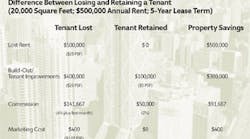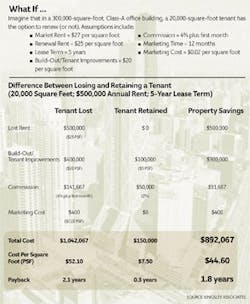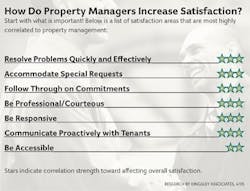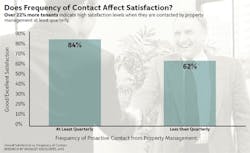You don’t have to be told twice: To satisfy tenants and occupants, it’s important to invest in your buildings and provide quality, high-performance, usable spaces. These investments are tangible, and indicate to tenants and occupants that you’re investing in them and their business. But, you also know that budgets don’t always allow for high-end upgrades or facility improvements.
So, what’s a facility or property manager to do? You want tenants and occupants to recognize your dedication to the advancement of their productivity and efficiency, but you may not have the dollars to show it. If you can relate to this predicament, there’s good news: Choose to make another type of investment. Experts concur that developing and preserving first-rate relationships with tenants and occupants is one of the wisest (and most cost-effective) investments you can make to ensure tenant/occupant satisfaction - and in multi-tenant environments, satisfaction leads to retention. You’ve already made great time and financial investments to attract these tenants; now, make the commitment to build and maintain relationships to make these investments pay off.
Peruse this Q&A and uncover solutions to tenant relationship problems that every facilities professional must face. You have the answers at your fingertips. What are you waiting for?
Q: What constitutes a quality tenant/occupant relationship?
A: Tony Smith, regional vice chairman of Los Angeles-based CB Richard Ellis’ Mid-South Region and IREM president, explains that in order to have a quality relationship, both parties need to recognize and appreciate the responsibilities and obligations of the other. If they don’t, catastrophe is sure to follow. For example: “If the tenant doesn’t understand what’s in the lease, then their expectations are different from reality. If the [property] manager doesn’t understand the lease, then again you get differing levels of expectations,” says Smith. And in cases like Smith describes, it’s important to make sure the lines of communication are open on both sides. “If they’re not, the relationship will fall apart.”
Jim Woidat, principal, Kingsley Associates, San Francisco, says that in his experiences, a property services professional’s ability to maintain an exceptional relationship with tenants begins with the support of the entire organization. “Whether you work directly for the owner-operator, or whether you work for a third-party service provider, you need to work for an organization that truly believes in the importance of customer service and provides you with resources you need to deliver it. Policies and procedures need to be very clear as to what service standards are - returning every phone call within 2 hours, proactively visiting tenants at least quarterly or monthly, etc.” He also emphasizes that outside vendors and contractors should be held to the same standards expected of the facilities/property management team.
Q: Where should I start when trying to develop a valuable tenant/occupant relationship?
A: “The key is to start the relationship from the time the tenant is only a prospect. The first impressions of your property and your staff will be lasting,” says Kurt Padavano, COO, Advance Realty Group, Bedminster, NJ. Develop a clear picture of tenant/occupant needs, expectations, and behaviors. As Woidat emphasizes, get to know the customer. Understand preferences, needs, how they prefer to communicate, etc. After all, they define value and quality. With a focus on defining value like your customers do, designing your offerings based on what customers value, and measuring performance in terms of the value that customers experience, you’ll achieve the relationship you’re striving for. “Rather than simply provide the best service possible and hope for the best, achieve an awareness of customer expectations and actively manage them,” says Mike Hoots, program coordinator at Colorado State University-Pueblo’s Facilities Management and Technology Studies Program. “ ‘Management’ implies an active rather than passive role by the service provider in influencing the customer’s perception of service success. The customer is in the driver’s seat - managing the relationship becomes your job.”
Appreciate your clients’ points of view: Do research and be prepared before meeting, and let tenants/occupants know that their requests and suggestions will be taken seriously. When they do share requests or concerns, San Rafael, CA-based Seagate Properties’ San Francisco General Manager Kirsten Walraven emphasizes the importance of listening carefully. “Don’t assume you understand what is being requested. Are there timelines you need to meet? Are there budget concerns? Ask clarifying questions to ensure that the property/facilities management team is spending time on the correct issue and, thus, the correct solution,” she says. And once the issue has been identified, provide a prompt response. Even if you don’t have answers, assure the tenant/occupant that you’re working on the problem, and provide them with a general timeline for completion. “I’ve always had the philosophy that the occupants of a building don’t really wish to deal with the property management/facilities team. They do [so because] they have to. The occupants’ focus for being there is to do the work they were hired to do. Thus, anything [you] can do to facilitate the ease of getting tasks and projects done, the better.”
“It sounds over-simplistic, but it’s all about communicating,” says Ralph Conti, partner and vice president of development at Cincinnati-based North American Properties. “Trust is earned - not given. Be consistent in your dealings with the tenant [or occupant]. The best thing to do is have face-to-face meetings. Lay out expectations from both sides of the table, and cross-reference those expectations. It’s very important that [you] understand customers’ expectations. If you start down a path without truly understanding what your client expects, when you get to the end of that path or hand them a building - or whatever it is you’re doing as a service provider - you can think you’re doing a great job, and be very disappointed when [the tenant/occupant] says, ‘That’s not what I wanted.’ ” Be clear about your department’s capabilities, and be realistic in terms of the commitments you make.
“Responsiveness is most valuable to a [tenant/occupant],” says Smith. “We’ve had [third parties perform] some statistical analyses to determine what the factors were that determined good tenant survey scores vs. not-so-good scores. The only factor where they could see a statistically significant correlation was with responsiveness, and so that’s where we’ve focused all of our attention.”
Q: What are some of the common slip-ups in the relationship-building process, and how can I avoid them?
A: Woidat explains that a common mistake is placing too much emphasis on the facility itself. “The quality of the building, the amenities that are in the building, the location - those are prerequisites for a tenant choosing a facility, but they ultimately don’t drive satisfaction. Our research shows that the factor that really drives satisfaction is service, first and foremost. It’s how they feel about your responsiveness, how frequently you’re communicating with them, and your ability to solve their problems. That is truly what drives customer satisfaction.” He also mentions that facilities professionals stuck behind closed doors is another frequent problem. It’s difficult to develop a rapport with tenants and occupants when you never see or talk to them. If you’re bogged down with deadlines and paperwork, brainstorm with team members for ideas on how to eliminate (or at least minimize) that setback.
Another helpful hint? Don’t say “no.” Hoots provides an easy-to-understand example: Imagine that a tenant requests trash pick-up five times per day instead of once. Although your department may only be funded to empty the trash cans once per day, don’t automatically say “no.” First, determine whether or not it’s a practical expectation (for example, the tenant should be aware that he/she will suffer numerous disruptions throughout the workday if trash is picked up five times). Then, take a closer look at the problem. Maybe instead of being emptied more often, additional receptacles are needed in the space. Or maybe the department simply needs larger trash cans. After weighing the options, you find that both you and the tenant agree that emptying the trash twice per day (instead of once or five times) is feasible - but that, according to your janitorial services agreement, the tenant must fund the extra service. Let the tenant be the one to make the ultimate decision. He/she can agree to pay more for the extra service they desire - or not. This way, you’re not saying no - the tenant will have to make that decision for him or herself. And as Walraven points out, “People like to hear what you can do for them, not what you can’t.”
“There are situations where a facilities professional cannot satisfy a tenant or occupant. Where a big mistake is often made is labeling that tenant as a ‘problem’ tenant and shutting down the relationship,” says Woidat. Rather than dismissing the relationship as one that won’t flourish, look for common ground, listen, and try to understand what’s driving the tenant’s perceived problem.
Q: What happens when I do make a mistake? How do I correct the problem and maintain trust?
A: Be honest: Admit that you made a mistake, and explain what you’re going to do to fix the problem. “ ‘Good service’ [doesn’t] mean that you and your team have to be perfect all the time,” emphasizes Walraven. “What is important is to accept responsibility when [you] have made a mistake, correct the error, and make efforts to learn from it. [Your] tenants/occupants know that people make mistakes. What matters is what happens when a mistake occurs. I’ve found that when you acknowledge the error, take responsibility for it, and at least meet (if not beat) their expectation for correction, you’ll still come out a winner.”
As Woidat explains, “A problem is really a golden opportunity to build customer loyalty. Often, it’s the customers who have experienced a problem resolved to their satisfaction that are likely to be your more loyal customers. When you treat every problem as an opportunity to wow your customer, you really do have the opportunity to build customer loyalty in delivering the solution.”
Respond quickly and honestly, have a plan for recovery before you talk to the effected tenants/occupants, apologize, and move forward with the relationship.
Q: What is the most appropriate way to deal with an unsatisfied tenant?
A: According to Walraven, there are normally two components associated with discontented tenants and occupants. No. 1: There was no resolution/completion. No. 2: The resolution/completion didn’t occur within the expected timeframe. She recommends two steps to deal with an unsatisfied tenant. Step 1: Take the time to listen to the true scope of the request, and get it resolved as promptly as possible. Convey expectations as to when the resolution will be met, and then meet the deadline. “The unsatisfied individual really doesn’t want to hear excuses. They want results,” she says. Step 2: Once the request has been handled effectively, move onto understanding where the breakdown occurred and why the problem happened in the first place. When the reason has been found, make sure procedures are put into place to prevent it from happening again.
Conti emphasizes the importance of addressing unhappy tenants in person. “Never handle a serious issue on a telephone,” he emphasizes. “If two reasonable people can sit across from each other, even the most serious of issues can generally be resolved. It just requires effort.”
“Our job, ultimately, is to solve problems,” says Smith. “There are going to be problems no matter what. If someone is unsatisfied, that means they have a problem that hasn’t been solved. The first thing [to do] is listen and make sure you understand their problem. Really ask probing questions to dig deeply and get to the heart of the matter. Then, [you] can step back and propose solutions. The listening and questioning process is really valuable in developing rapport with the tenant.”
Q: How can I maintain a good relationship once a good foundation has been established?
A: Day-to-day communication is vital to let tenants and occupants know you haven’t forgotten about them or their requests. Every opportunity you have to spend time with a tenant or occupant (no matter how short or long) can help develop a stronger connection between the two parties. And if tenants are aware that you’re investing in your relationship with them, chances are that they’ll be more likely to reciprocate.
Make sure requests and concerns are followed up on, and ensure that the tenant/occupant knows that the problem has been resolved (even if you think they’re already aware). It may seem like a waste of time, but this type of communication is imperative to a successful relationship. It’s okay to admit that you don’t have the answers they need. Let the requestor know that you’re not sure, but that you’ll get back to him/her with possible options as soon as you can.
Become a resource. The Chicago-based Institute of Real Estate Management’s (IREM’s) Commercial Tenant Retention Key Report advises property managers to offer advice to tenants on how to make the most of their particular location. Turn their attention toward traffic patterns and ideas that may draw more customers. Let tenants and occupants know about upcoming events that may be of interest to them (whether those events are located inside your building or elsewhere).
Smith indicates that, to maintain quality relationships, CB Richard Ellis places prominence on a sense of community. “Have social events for tenants so they get to know each other, and can start doing business with each other. This way, it’s a lot easier for them to overlook a problem in the management of the property when it comes time to renew if they’re doing business with everybody else in the building. They won’t want to leave.” Other facilities professionals hold regular meetings for tenants and occupants, allowing time to voice thoughts, concerns, frustrations, and praise. These gatherings may become very valuable for attendees - tenants and occupants can share business advice with each other and offer ideas and suggestions, turning the meeting into a networking opportunity for everyone.
IREM’s Commercial Tenant Retention Key Report also suggests developing an internal website or other point of contact where tenants and occupants can immediately go to get answers to questions, find out about upcoming renovation projects, and get inside info on future building events. “Our job and value as a [facilities professional] goes way beyond just operating the property,” emphasizes Smith. “It’s helping the tenants do their business better. If you’re helping them do their business better, then that relationship is going to build and strengthen over the years.”
Leah B. Garris ([email protected]) is associate editor at Buildings magazine.






